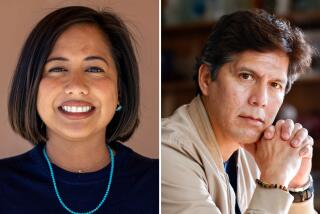L.A. elections may be decided by older, white voters, poll shows
Tuesday’s elections will sweep in new leadership for Los Angeles’ 3.8 million residents, but the races are likely to be decided by an older, whiter and more educated fraction of the city’s population.
Latinos, the city’s dominant ethnic group and a key voting bloc, make up 44% of the city’s population, U.S. Census figures show. But a USC Price/Los Angeles Times poll of likely voters last week suggests Latinos will make up 24% of those who cast ballots Tuesday, in part because many are immigrants who are ineligible to vote.
Non-Latino whites, by contrast, at 32% of the city’s population, are likely to total 51% of the vote, giving them an outsized role in choosing the next mayor, according to the poll.
Apathy among young people could diminish their clout too. Of the city’s voting-age population, 65% are under 50. But only 37% of those likely to vote are under 50.
The poll of 500 likely voters asked a series of demographic questions and underscored the longstanding, sharp disparities between the voters who choose the city’s leaders and the far larger population they represent.
“The issue base for affluent, more educated, older voters, what they care about — their priority list is different than less educated, lower-income, younger voters,” said Antonio Gonzalez, president of the Southwest Voter Registration Education Project.
Latinos may be underrepresented in L.A. elections. But in the current contest for mayor, candidates Wendy Greuel and Eric Garcetti have recognized them as a growing and potentially decisive body of voters.
Latinos now represent more than twice the share of likely voters they did 20 years ago, according to Times polling surveys. Greuel, Garcetti and their allies have targeted Latinos with a flood of bilingual mailers, Spanish-language television ads and endorsements from some of the community’s political, entertainment and civil rights leaders.
“We believe the candidates really have recognized the importance of the Latino vote,” said Rosalind Gold, senior director of policy, research and advocacy at the National Assn. of Latino Elected and Appointed Officials.
“We’ve seen both mayoral candidates actively pursuing endorsements from Latino leaders, going to venues where they expect there will be Latino constituents, seeking support from Latino civic organizations. It’s clear both candidates realize they cannot win this election without a viable strategy to reach and win Latino voters.”
In the final days of the election, both mayoral candidates also made a major push for African American votes.
The USC Sol Price School of Public Policy/LA Times Los Angeles City Primary Poll found that African Americans made up 12% of likely voters. They make up 9% of the city’s population.
In the March mayoral primary, the city’s heavily African American neighborhoods strongly favored Councilwoman Jan Perry, who failed to make the runoff.
Also on Tuesday’s ballot are races for city attorney, city controller, City Council and the L.A. Unified and L.A. Community College District school boards, along with a handful of ballot measures, including three on medical marijuana dispensaries. Polls are open from 7 a.m. to 8 p.m.
More than 167,000 of the roughly 400,000 people expected to vote have already cast ballots by mail, according to the city clerk’s office.
On Monday, Greuel and Garcetti raced across Los Angeles, beseeching supporters to turn out and vote. Campaigning at a Sherman Oaks senior center, Greuel recalled squeaking onto the City Council 11 years ago by a mere 242 votes.
“I had to wait 10 days to find out I’d won,” Greuel said before making the rounds at a bingo lunch. “I know how important it is to get every single vote out.”
Greuel sought to make her case again to the older crowd, saying her career in the public and private sectors made her uniquely qualified to spur job growth in a city still recovering from recession.
At the same time, her No. 1 surrogate, former President Clinton, made a pitch for her in an automated call to voters.
“She won’t just be the first woman mayor of L.A. — she’ll be the best mayor,” Clinton told those answering the phone.
Garcetti, too, struck the jobs theme as he greeted voters eating pancakes and omelets at a Pacific Palisades cafe on Monday morning, taking credit for the comeback of Hollywood, Silver Lake and other parts of his council district.
“I’m campaigning like I’m 20 points behind,” he said.
Later, he set off on a light rail and subway tour of the city at the Crenshaw station on the Exposition line. A homeless man on a train told Garcetti to keep gathering votes the way he collects empty cans. “One at a time, and you will get there,” he said, before offering the candidate a fist bump and a handshake.
In another automated phone call, U.S. Rep. Xavier Becerra (D-Los Angeles) told voters that Garcetti, who is part-Mexican, had “fought on behalf of Latino families.”
In addition to demographic differences between likely voters and the city population as a whole, Times’ analyses of this year’s voting patterns have highlighted the sharp geographic disparities in the vote. In the March primary, Westside and West Valley council districts produced more than triple the number of votes than were cast in a South Los Angeles district.
Neighborhoods that produce the most votes, political consultants say, often are the same ones that are most organized and vocal about getting their trees trimmed, potholes filled and parks maintained.
“There is a squeaky wheel aspect to government,” said Mike Shimpock, a veteran Democratic political operative. “There always has been.”
Times staff writers Kate Linthicum, Jean Merl, James Rainey, Maeve Reston, Catherine Saillant and David Zahniser contributed to this report.
More to Read
Sign up for Essential California
The most important California stories and recommendations in your inbox every morning.
You may occasionally receive promotional content from the Los Angeles Times.












